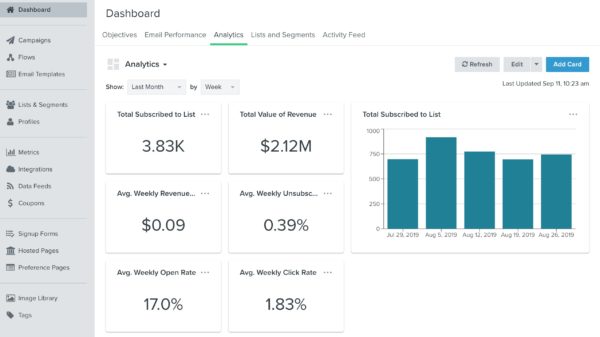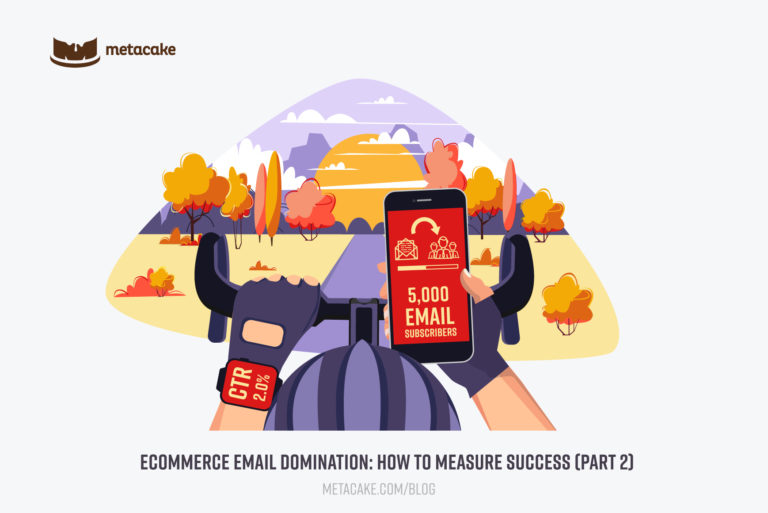“What gets measured, gets managed.” – Peter Drucker
Did you know these wise words from Peter Drucker apply to your ecommerce email strategy? There is no way to create a profitable email program without being able to measure the effectiveness of everything you create and send. That is why the first step of ecommerce email domination is to strategically answer 2 questions: what do you need to measure and how can you accurately track these metrics?
These questions actually lead us to our first decision: what platform should you use? The platform you choose will greatly affect your ability to do a lot of things, but most importantly, it will affect what you’re able to measure easily.
Choosing The Right Ecommerce Email Platform
When selecting a platform, make sure that it has the analytics you need and that it can integrate with your ecommerce store and other platforms that are relevant to the email program. This way, all of your data can flow between platforms and you can truly measure the effect your email program has on your customers and your store.
For the purposes of this guide, we are focusing on Klaviyo. It’s the leader for ecommerce email marketing and the platform we use to generate significant monthly revenue for our brands. Klaviyo was the first truly integrated email platform designed for ecommerce, complete with automation capabilities, valuable data, and ease of use. You can read more about our review of Klaviyo here.
If you’re in the ecommerce space, it’s hard to beat Klaviyo. However if you do look around, start with making a list of “must haves” and “nice-to-haves” to determine which platform fits your criteria best. Overall, there are three areas to keep in balance: budget, features and metrics available, and ease of use. Don’t underestimate the value of a program that’s simple to operate. It’s better to pay more for your account than to have to pay a fortune for the resources to run a complicated email platform.
An alternative to Klaviyo is Drip, which has many similar features, but is less powerful and less mature as a platform. If you’re using Mailchimp for ecommerce, you shouldn’t be. It simply is not built for what you need. In addition, unless you have other parts of the business that warrant it, platforms like Marketo and Hubspot are great, but not in the context of pure ecommerce.
What Metrics Matter?
Once you’ve selected a platform, it’s time to familiarize yourself with the most important metrics to use to judge the health of your program. Here are the top five to watch:
1. List Size
As you build your email program, the first milestone to aim for is a list of 5,000 quality people and then strategically scale from there. If you’re feeling intimidated by how to grow your list quickly (or tempted to do it sneakily— hint: don’t), remember that the great brands that are growing virally can see amazing success with a list of just 30,000. You don’t necessarily need 1 million people. A smaller, highly engaged list is the most effective path, every time.
Metacake Recommended Benchmark: Minimum 5,000 quality names with strategy to double within 6 months.
2. Open Rates
Watching your open rates are important because it measures your emails’ relevance. It shows how much you are able to capture the attention of your subscriber in a sea of other emails.
If you are using Klaviyo, you will have the ability to A/B test your subject lines by sending two different subject lines out to a portion of your list for a period of time. Klaviyo will then select the winning subject line based on the open rate and push that one to the remainder of the list. This is a great way to test strategies to capture attention and narrow down what your audience responds well to.
Metacake Recommended Benchmark: 20% open rate or higher
3. Click-Through Rates (CTR)
Just as important as open rates are your emails’ click through rates. This measures the percentage of email openers who clicked on any call to action in the email and landed on your site. CTR is a good indication of whether you delivered on your subject line and how compelling your email content is.
Klaviyo also has the option to A/B test for clicks. For this test, you can create two or more versions of an email with different calls to action or creative. Klaviyo will test these variations against each other to a portion of your list for a period of time (for example, you might choose to send tests to 20% of the list for one hour). The “winning” email with the highest click-through rate will send to the rest of the list.
We discuss more about how to increase email CTRs in this article.
Metacake Recommended Benchmark: 2.0% click rate or higher
4. Unsubscribes
It’s normal and healthy for names who are not interested to unsubscribe from your list. However, keep an eye on this metric. A high unsubscribe rate could be an indicator that you are burning out your list with too many emails or irrelevant emails.
For most brands, we stick with a frequency of one to two relevant emails per week. The exception is during the holiday season, which calls for many more. In addition to frequency, make sure you’re intentional about what you send as well. We have a simple rule: add value with every email we send. If the email doesn’t add value to the customer, we don’t send it. As always, our goal is to create raving fans and that’s done by adding value. Simply creating customers does not generate massive business success. We typically recommend a 1:1 ratio of promotional emails that sell vs. content emails that inform and build relationships.
Metacake Recommended Benchmark: 0.20% unsubscribe or lower
5. Revenue per email per send
Finally, be sure to measure the amount of revenue your email program is generating. This should be something easy to see and it should be accurate. If your email platform is integrated with your ecommerce store, it will be easy to see the total revenue earned from each email sent. However, this number can be a little misleading when it comes to assessing the health of your strategy and your list. A more specific measurement to watch is revenue per email per send. For each email sent, simply divide the revenue earned by the number of names that received it. For example, if a campaign of one email sent to 30,000 names earned $3,000, the revenue per email per send would be $0.10.
Keep in mind that not every email needs to be revenue-focused. Some are simply about staying top of mind. We’ll explain this in detail in our next post, where we unpack three important types of emails to include in your strategy (Sign up for our Growth Academy Newsletter to be notified when it drops).
Metacake Recommended Benchmark: Minimum average $0.10 per email per send
How do you measure up?
Are your metrics measuring up to the benchmarks outlined above? If you find that you’re falling behind in areas such as open rate and CTR, this is a clear call to start segmenting and testing. Even if your metrics look good, this practice is still worthwhile to avoid burning out your list.
Segmentation
Segmentation is simply dividing your list into smaller segments based on similar behaviors or interests. This allows you to get more specific in the types of content and offers you send, and you’re much more likely to see higher engagement. Whether you’re segmenting or still sending to your whole audience, it’s important to continue A/B testing subject lines, email structure, creative, and calls to action as well.
Tracking
Another important part of measurement is to make sure you’re using Google analytics UTM tracking codes for every link included in emails. Many platforms (including Klaviyo) will automatically include UTM parameter tracking for you, but you can also use this URL builder extension to make tracking easier.
Whichever email platform you choose must be able to report all of the metrics we’ve discussed so far. For an example of what to look for, check out how Klaviyo’s analytics dashboard is set up below. However, when you’re diving into your own program’s metrics, it’s important not to rely on one data source. It’s always good to cross-reference this data with Google Analytics to watch how your email strategy affects the rest of the site.

